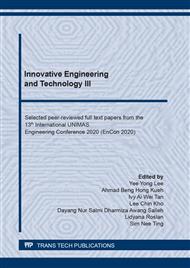[1]
Sa'don, N.M, Abdul Karim, A.R. Taib, S.N.L, and Yusof, M. (2018). Strength properties of reinforced peat using fiber-polyester and shredded rubber-crumb as reinforcement material. International Journal of Engineering & Technology. 7 (3.18) pp.26-30.
DOI: 10.14419/ijet.v7i3.18.16667
Google Scholar
[2]
Saberian, M. and Rahgozar, M.A. (2016). Geotechnical properties of peat soil stabilized with shredded waste tyre chips in combination with gypsum, lime or cement. Mires and Peat. Vol.18 (16); pp.1-16.
Google Scholar
[3]
Yixian W., Panpan, G., Shengbiao, S., Haiping, Y., and Binxiang, Y. (2016). Study of strength influence mechanism of fiber reinforced expansive soil using jute. Geotechnical Geology Engineering, 34, pp.1079-1088.
DOI: 10.1007/s10706-016-0028-4
Google Scholar
[4]
Daud, N.N., Yusof, Z. M. and Muhammed, A.S. (2015). Ground improvement of problematic soft soil using shredded waste tyre. 6th International Conference on Case History in Geotechnical Engineering. pp.1-5.
Google Scholar
[5]
Sariosseiri, F. and Muhunthan, B. (2009). Effect of cement treatment on geotechnical properties of some Washington State soil. Engineering Geology. 104, pp.119-125.
DOI: 10.1016/j.enggeo.2008.09.003
Google Scholar
[6]
ASTM D4609-Standard Guide for Evaluating Effectiveness of Admixture for Soil Stabilization.
Google Scholar
[7]
Maheshwari, K., Solanki, C. H., and Desai, A.K. (2013). Effect of polyester fibers on strength properties of clayey soil of high plasticity. International Journal of Scientific & Engineering Research. Vol. 4, Issue 6, ISSN 2229-5518.
Google Scholar
[8]
Mirzababaei, M., Miraftab, M., Mohamed, M., and McMahon, P. (2013). Unconfined compression strength of reinforced clays with carpet waste fibers. Journal of Geotechnical and Geoenvironmental Engineering, ASCE. Vol. 3, pp.483-493.
DOI: 10.1061/(asce)gt.1943-5606.0000792
Google Scholar
[9]
Patel, S.K., and Singh, B. (2014). Unconfined compression strength of behavior of fibre- reinforced lateritic soil. Journal of Civil Engineering and Environmental Technology. Vol. 1(4), pp.93-98.
Google Scholar
[10]
Hambirao, S. and Rakaraddi, P. (2014). Soil stabilization using shredded rubber tyre chips. IOSR Journal of Mechanical and Civil Engineering. Vol. 11(1), pp.20-27.
DOI: 10.9790/1684-11152027
Google Scholar
[11]
Gao, L., Hu, G., Xu, N., Fu, J., Xiang, C., and Yang, C. (2015). Experimental study on unconfined compressive strength of basalt fibre reinforced clay soil. Advances in Materials Science and Engineering. Vol. 2015, Article ID 561293, 8 pages, 2015. https://doi.org/10.1155/2015/561293.
DOI: 10.1155/2015/561293
Google Scholar
[12]
Kalantari, B. Prasad, A. and Huat, B.K. (2010). Peat stabilization using cement, polypropylene and steel fibres. Geomechanics and Engineering. Vol. 2(4); pp.000-000.
DOI: 10.12989/gae.2010.2.4.321
Google Scholar
[13]
Kalantari, B. Prasad, A. and Huat, B.K. (2012). Use of cement, polypropylene fibers and optimum moisture content values to strengthen peat. International journal of Physical Sciences. Vol. 7(8); pp.1276-1285.
DOI: 10.5897/ijps10.619
Google Scholar
[14]
Skels, P., Bondars, K. and Korjakins, A. (2013). Unconfined compressive strength properties of cement stabilized peat. In Civil Engineering 13, 14th international Scientific Conference Proceedings. Vol. 4, Part 1, pp.202-206.
Google Scholar
[15]
Thiruvangodan, S. K., (2006). Waste tyre management in Malaysia, PhD Thesis, Faculty of Environmental Studies, University Putra Malaysia.
Google Scholar
[16]
FHWA (2008). User guidelines for by-product and secondary use materials in pavement construction. FHWA-RD-97-148. Federal Highway Administration, Washington DC.
Google Scholar
[17]
British Standard 1377: Part 2 (1990). Classification Tests. Soils for Civil Engineering Purposes.
Google Scholar
[18]
Ghani, A. N.A., Ahmad, F., Hamir, R. and Mohd, S. (2003), Yielding behavior of scrap tire based lightweight geomaterial subjected to repeated load. 2nd International Conference on Advances in Soft Soil Engineering and Technology, 2 – 4 July 2003, Putrajaya, Malaysia.
Google Scholar
[19]
Edil T. B. (2003), Recent advances in geotechnical characterization and construction over peats and organic soils,, 2nd International Conference on Advances in Soft Soil Engineering and Technology, 2 – 4 July 2003, Putrajaya, Malaysia.
Google Scholar
[20]
Jarrett PM (1995). Geoguide 6. Site investigations for organic soils and peat. J.K.R. Document 20709-0341-95. Institut Kerja Raya Malaysia, Sarawak.
Google Scholar
[21]
ASTM D2976-15, Standard Test Method for pH of Peat Materials, ASTM International, West Conshohocken, PA, 2015, www.astm.org.
Google Scholar
[22]
Davies, J. Mathew, U., Aikanathan, S., Chik, N.Y. and Chong, G. (2010). A quick scan of peatlands in Malaysia, Wetlands International, Malaysia.
Google Scholar
[23]
Kalantari B and Huat B.K. (2008) Stabilization of peat soil using ordinary Portland cement, polypropylene fibers and air curing technique. Electronic Journal of Geotechnical Engineering, 13.
Google Scholar
[24]
Kumar, A., and Gupta, D. (2016). Behavior of cement-stabilzed fiber-reinforced pond ash, rice husk ash-soil mixtures. Geotextiles and Geomembranes, 44, 466–474.
DOI: 10.1016/j.geotexmem.2015.07.010
Google Scholar
[25]
JKR Malaysia. (1985). Manual on Pavement Design, Arahan Teknik (Jalan) 5/85. Malaysia: Jabatan Kerja Raya Malaysia.
Google Scholar


